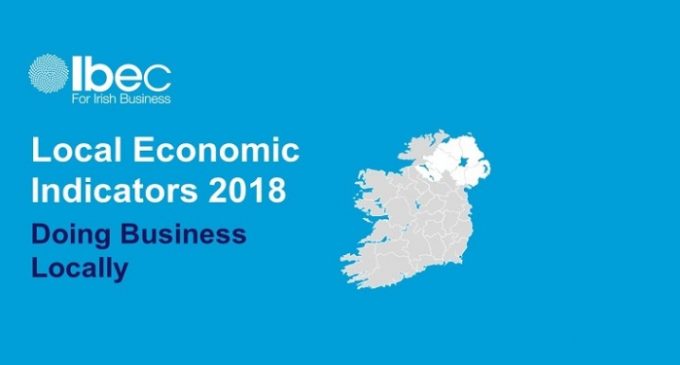Ibec Publishes Latest Local Economic Indicators Report

Ibec, the group that represents Irish business, has launched Local Economic Indicators 2018: Doing Business Locally. The annual report measures data from across eight regions and in all 31 local authorities.
Local Economic Indicators 2018 is an evidenced-based report compiled from publicly available data. It provides insights for future policy planning in relation to eight categories: population, housing, skills, broadband, travel/commuting, tourism, local enterprise development and local government finances.
Commenting on the report, Ibec Senior Public Sector and Regulatory Executive Aidan Sweeney, said: “Ibec’s ambition is to make Ireland a better place to live and work. To sustain economic growth and ensure that it can be better shared across the country, all regions across the country must offer strong quality of life and employment opportunities.
“Regional and individual local data breakdowns provide unique economic and social insights. This allows us to better understand the strengths and weaknesses of the economy at a local level across a range of areas.
“The report provides a state of play of local and regional competitiveness. We do not limit performance monitoring to areas that are in direct local control and include indicators that fall outside the remit of local government. The findings provide an important window to the performance and impact on the ground of national and regional policies. Paying ongoing attention to them will help determine the success of the National Planning Framework and other national strategies,” he said.
Some of the key findings of the Local Economic Indicators 2018 include:
Key findings:
- Companies locating where talented workers want to live, not the other way around: Quality of life factors such as the availability and affordability in housing is a growing determinant of our ability to compete internationally.
- Ireland’s talent pool remains our key global competitive advantage: 43% of the labour force is educated to at least degree level. This varies substantially across regions and local areas. In Dún Laoghaire-Rathdown, over seven in every ten people in the labour force have completed at least a level 7 degree, but only three of every ten in Cavan hold a degree.
- Skilled workforce, production of STEM graduates and innovation essential to regional productivity: It is not surprising the that highest concentration of STEM-graduates Galway City, Cork City and across Dublin but Monaghan has the lowest.
- Northern and Western region most dependent on the National Broadband Plan: Over 50% of premises in Leitrim are dependent on the National Broadband Plan (NBP), with Monaghan (48%) and Roscommon (47%) second and third highest in terms of NBP dependency.
- Accessibility to ports and airports for high quality international connectivity: The North West ranks the lowest in the country in terms of travel time to a State airport or major Tier 1 or 2 designated port. This plays a significant role in making the region appear inaccessible.
- Work must continue on improving road connectivity and road quality locally: Poorly maintained local authority roads can have a significant impact on local competitiveness. Galway City is the best local authority and the Mid West the best region in terms of road quality with the worst local authority area being Fingal and the Midlands region.
- Invest in public transport to tackle excessive commuting times: Almost one in three people have a daily commute of 30 minutes to an hour each way. However, the most extreme cases exist in the counties immediately bordering Dublin (Kildare, Meath and Wicklow) where one out of every five people spends a minimum of two hours every day commuting.
- Coastal cities and regions generate highest overseas revenue from tourism: Approximately 45% of overseas tourist spend occurs in the nine counties of the Wild Atlantic Way, which shows the benefit collaborative-initiatives can have on the local economy. Dublin and Cork alone generated more revenue than every other county combined.
- Local job creation should focus on a mix of FDI, indigenous companies and entrepreneurship: With approximately 2,700 jobs per 10,000 of the labour force, Cork performs strongest in terms of IDA and Enterprise Ireland-supported jobs.
- Commercial rates impact on local business conditions and cost competitiveness: In 2018 business contributions will directly account for €1.51 billion or 35% of the total local government budget. Dublin’s four local authorities have the highest average rates bill for local businesses.
























